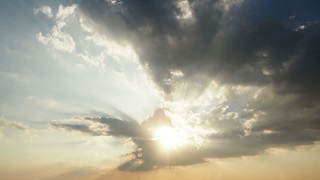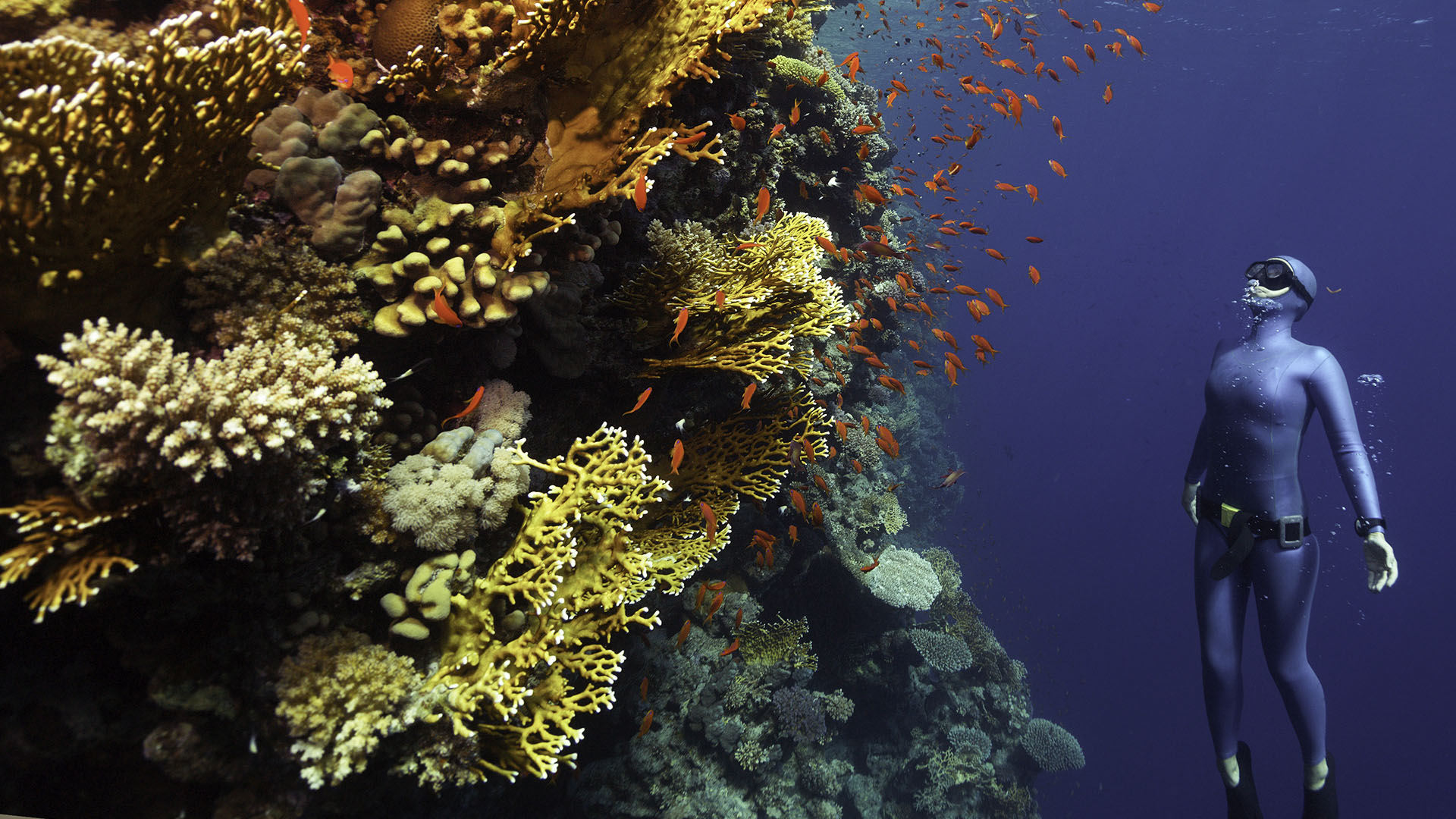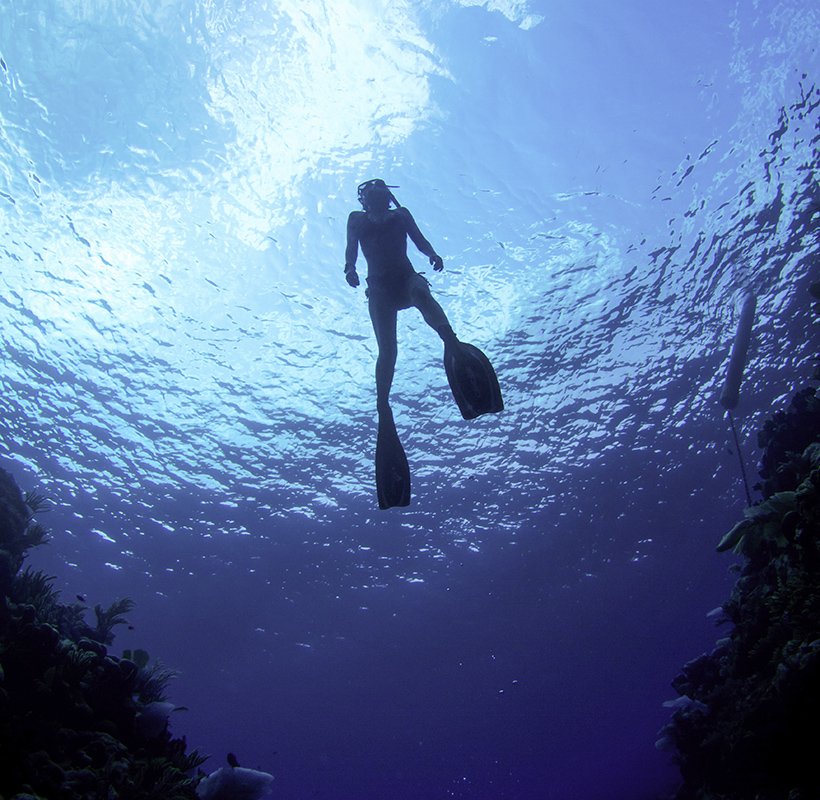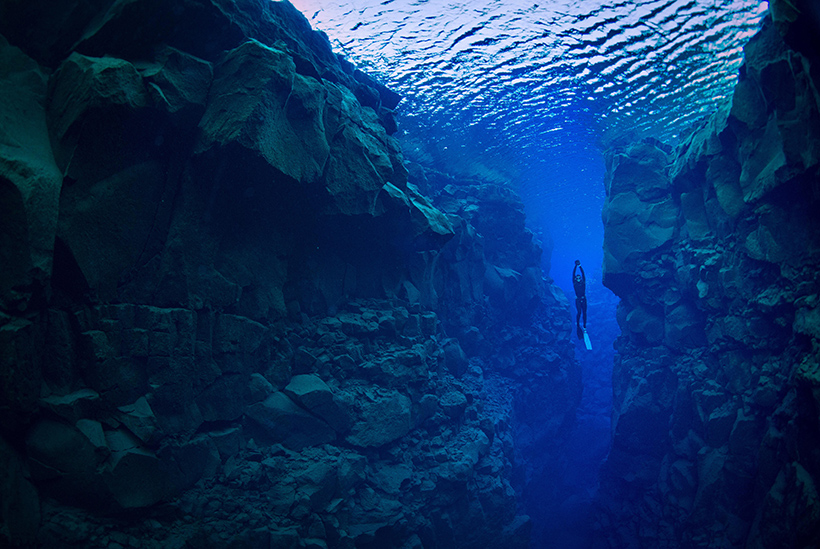
Enter a cloud
Inspired by 'Gigantic Cinema' | Issue 20 | 2022


Freediving requires that you enter into a state of total, meditative calm. To preserve oxygen, every single muscle relaxes, the breath slows, all thoughts become still.

I became a freediver to connect with the underwater world in the purest way. My goal is to swim with large aquatic mammals and pelagic fish such as seals, dolphins and whale sharks. Freediving also allows me to indulge my passions for photography and film. The sport marries many of my interests—exploration, history, science and nature. My partner and I recently tried underwater foraging for scallops, crabs and lobsters with our hands, as ancient divers did. To get ten scallops took us repeated dives ten metres down over three hours.
To me, freediving is a form of meditation in movement: it’s about the synergy of mind, body and spirit. It has much in common with Buddhist meditation, another important part of my life.
Every time I dive, I take a journey. Sometimes, I feel as though I’m travelling into space, into a great expanse of unending blue. Sometimes, the experience is intensely physical—I sense the movement of my limbs through water. But most often, I feel a deep connection to nature and life itself.
There are scientists who think that life began more than three billion years ago in deep-sea hydrothermal vents. An aquatic microorganism may be the common ancestor to all living things. There is a richness to the underwater world that amazes me. I think life must have begun in water: I believe we were born of the sea.

Freediving is the art of diving underwater on one breath without the aid of mechanical devices. Common among ancient cultures around the world as a means of gathering food and resources, the first documented dives date back to 5400 BC. Greeks collected sponges off Kalmynos island and the Ama divers of Japan gathered pearls. Freedivers were also employed for the salvage of valuable items from sunken ships and to sabotage enemy vessels or ferry supplies. Spearfishing has its roots in freediving, too.
I have had a lifelong fascination with the sea. As a child, I consumed every book and documentary I could about the oceans and I swam from an early age. I spent most of my childhood summers in pools, lakes and oceans in Canada, Mexico and the Caribbean. I have a PADI Advanced Open Water scuba diving qualification and have done about fifty dives around the world, including some wrecks. Freediving was really the next natural step.
There is no time like the present. I joined a freediving club in London this year and became a certified freediver this summer. There are about ten freediving clubs around the UK. My club, which has thirty regulars, trains every Monday at a pool at the Queen Mother’s Sport Centre in Victoria. We also meet regularly on weekends to dive in open water—lakes, dedicated watersports quarries, and the sea. My partner is a freediver, too, although we met before we each qualified. Over the past six months, the club has become a family to us. It’s a diverse, international group and the wider freediving community has been so welcoming. I love the camaraderie of training and exploration.
As a new freediver, you learn a lot about safety, science and, specifically, the mammalian dive reflex. This reflex allows mammals to optimise respiration underwater for extended periods of time. Aquatic mammals like seals and dolphins exhibit this trait most strongly but it also exists in humans. The reflex is triggered by cold water contacting the face. When this happens, various changes happen in the human body which allow for the greater conservation of oxygen, namely the slowing of the heart rate and the shift of blood to the lungs, heart and brain.
Freedivers hack into this dive reflex. We learn to stack the odds in our favour through extensive and specialised training in and out of the water. Cardiovascular endurance, flexibility, mobility, alignment, and strength are critical. Although it looks like freedivers move gently through the water, freediving is anaerobic and is metabolically closest to sprinting. So we do a lot of interval training in the pool and in the gym: short sprints or bursts of activity with brief periods of rest.
On land, we practise yogic and sequential breathing exercises and learn to breathe fully. This helps to increase our tolerance to higher levels of carbon dioxide, which is what actually triggers the urge to breathe even if oxygen reserves are sufficient. We never, ever hyperventilate before diving—that is dangerous and disturbs the mix of gases in our blood. Safety is the number one priority. Freedivers learn never to dive alone without a certified ‘buddy’ who observes each dive. Rescue is also a part of our ongoing training. We have total respect for the water, especially the ocean with its tides and currents.
Physics also comes into play at depth. As we descend into water, the pressure around us increases at a rate of one bar every ten metres. The pressure in the airspaces in our sinuses, ears, and diving masks also increases. To relieve this pressure, we need to ‘equalise’ these cavities by pushing air into them. This is often done by pinching and blowing one’s nose at the same time, which forces air into these spaces. Equalisation is probably one of the most challenging and important aspects of freediving. The deeper a diver goes, the more sophisticated the equalisation technique must become. Anything beyond thirty metres of depth becomes highly technical.
We don’t use air tanks but we do use specialised equipment. A freediving fin is double the length of a normal scuba diving fin and much wider; my fins are the length of my legs and you need to use a long kick from the hip to propel yourself with them, hence the need for core strength. A freediving mask has a lower volume than normal masks, which means less air is required for equalisation. To control our buoyancy, we use a few kilogrammes of weight fastened to belts. And to prevent our core temperatures from dropping, we use two-piece open-cell neoprene wetsuits. Open-cell neoprene is effectively a smooth rubber and it melds so closely to the skin that we have to lubricate the suits to get into them. This kind of wetsuit also allows for a great range of mobility and streamlining.
Given how technical freediving is, an official body was formed to set safety standards and govern competitive freediving events—AIDA, l’Association Internationale pour le Développement de l’Apnée. AIDA is also one of the main organisations responsible for freediving certification. After several months of training and study, I achieved my AIDA 2 Star qualification, which involved taking a written exam as well as fulfilling specific diving, swimming and safety requirements. The exam tests your knowledge of biology, physics and anatomy as well as safety protocols. The technical requirements require a two-minute static breath hold in the water (‘static apnea’), a forty-metre horizontal swim underwater on one breath with fins (‘dynamic apnea’), and a dive to a depth of sixteen metres on one breath with fins (‘constant weight’). These are the main freediving disciplines and I’m working on safely extending my performance in each area.
In most sports, one thrives on adrenaline. But freediving requires that you enter into a state of total, meditative calm—even in competition. To preserve oxygen, every single muscle relaxes, the breath slows, all thoughts become still. For all the physicality of the sport, I think freediving is ultimately in the mind.
Freediving should not be undertaken without appropriate certification, supervision, training and fitness.
© Norton Rose Fulbright LLP 2025